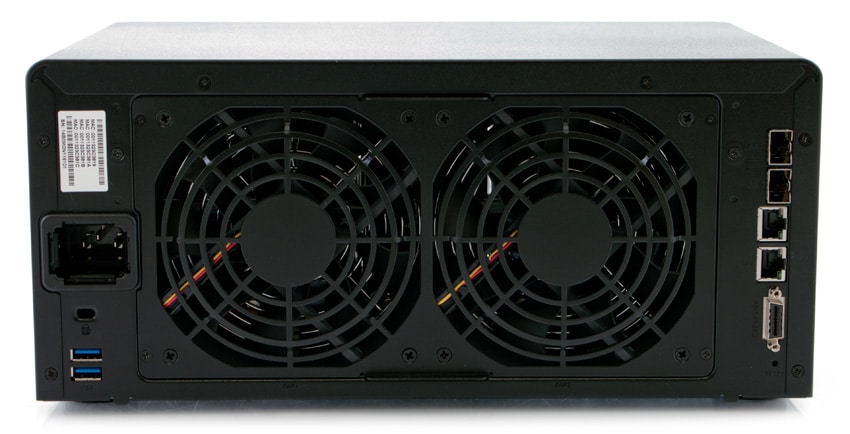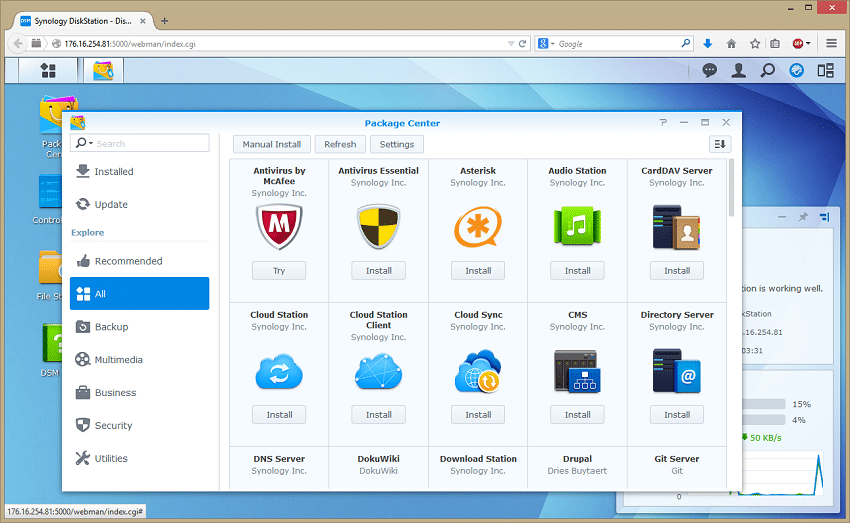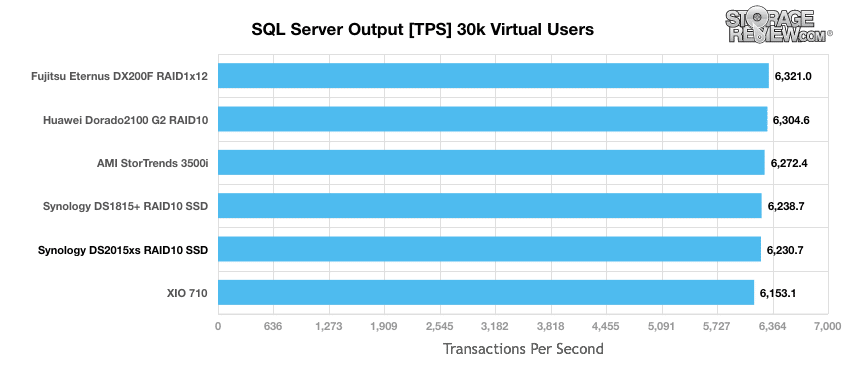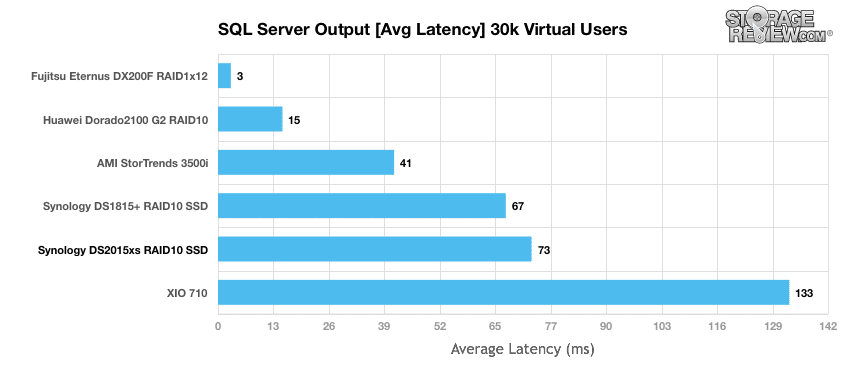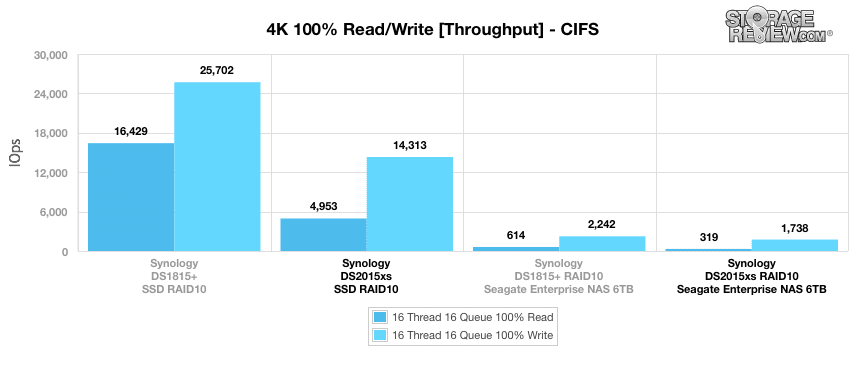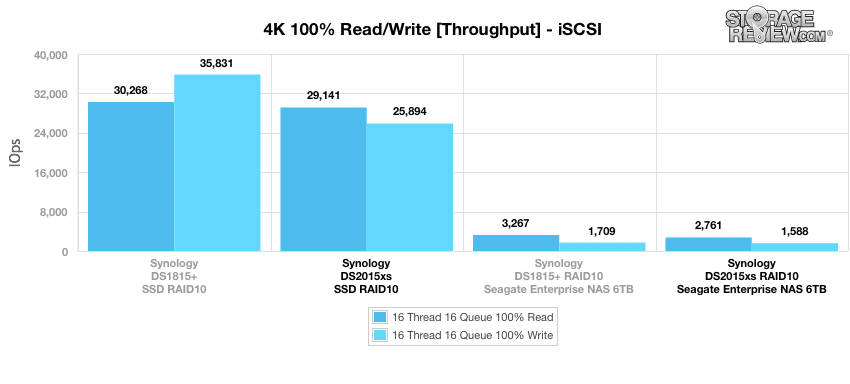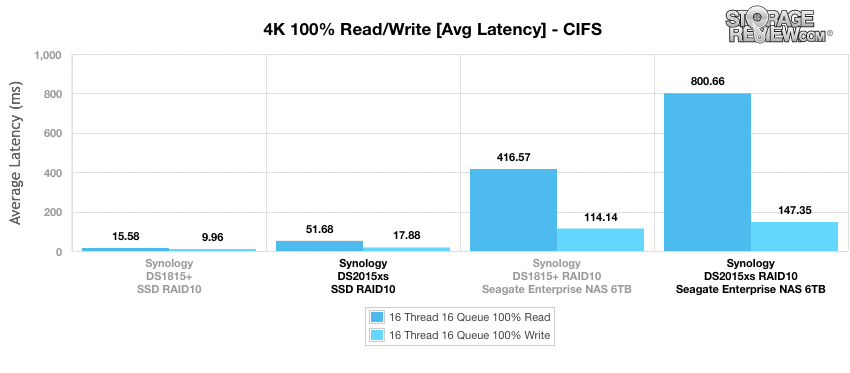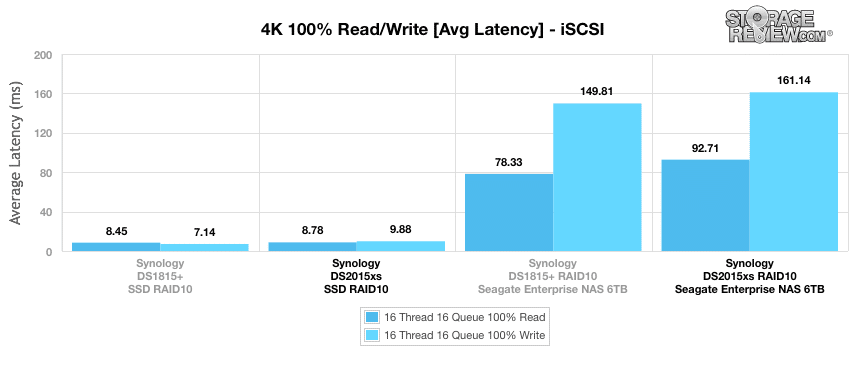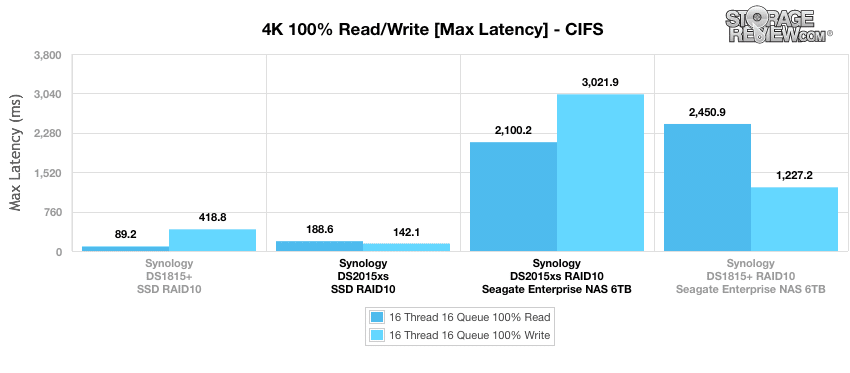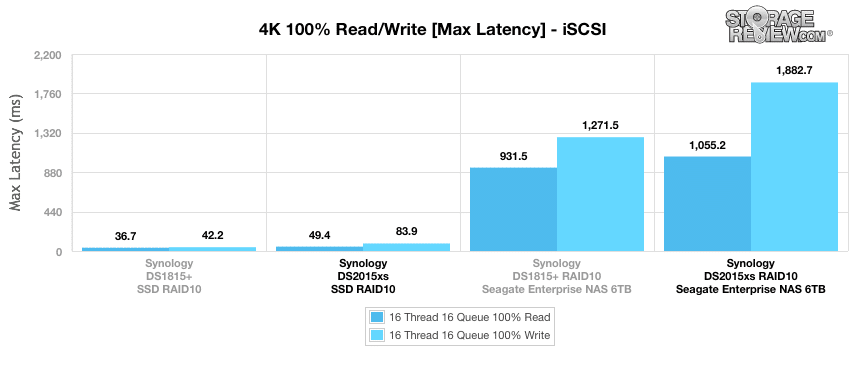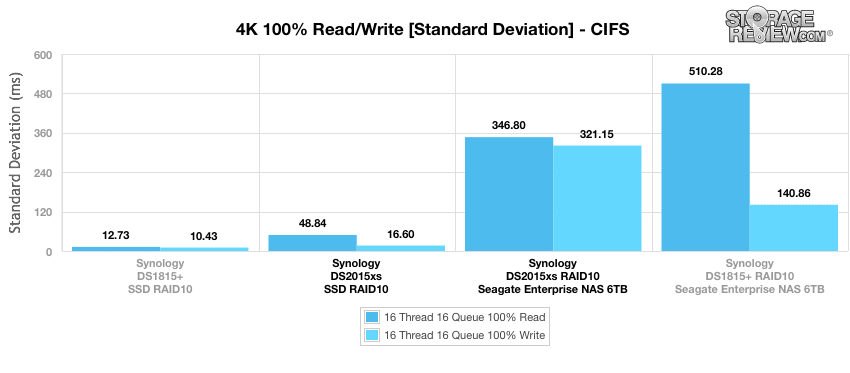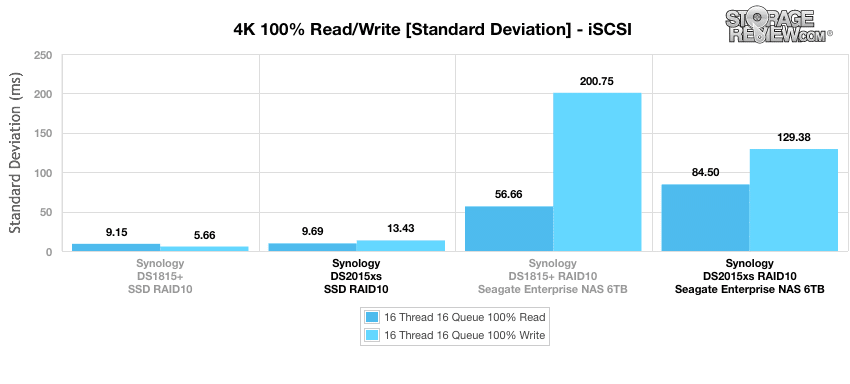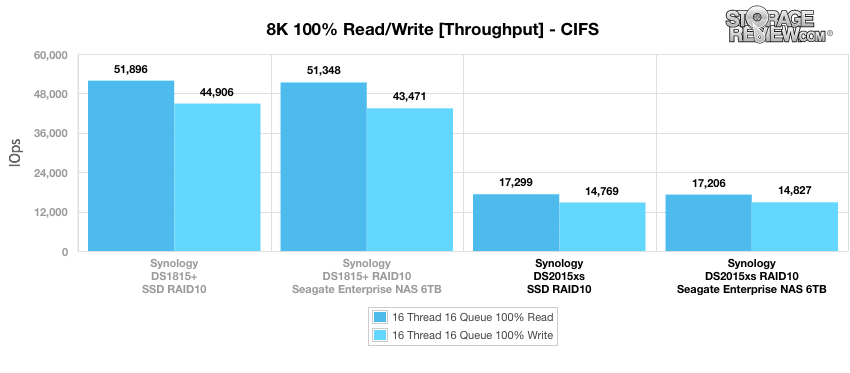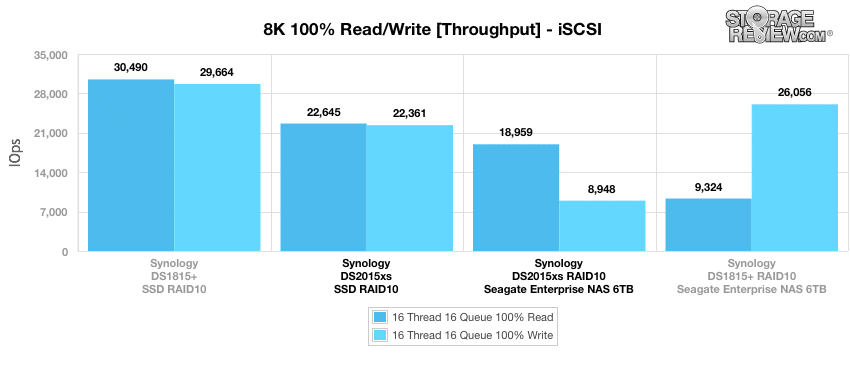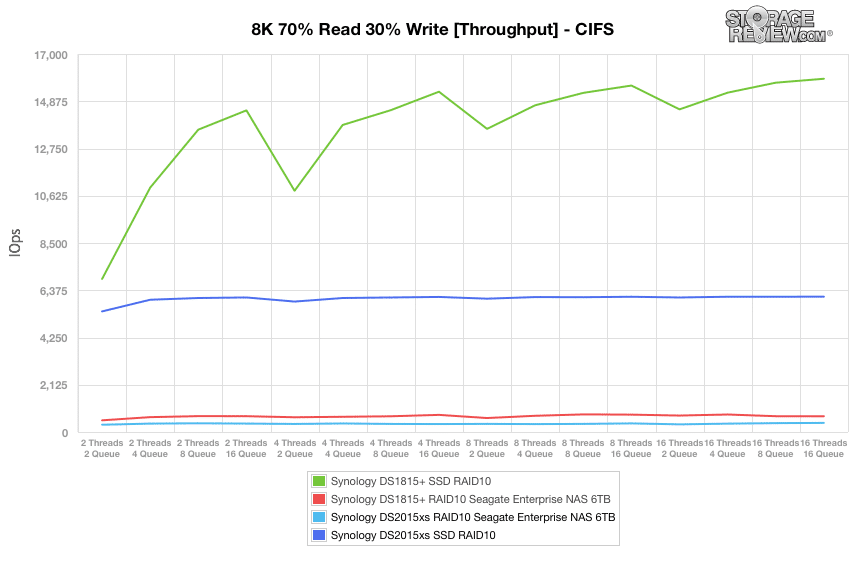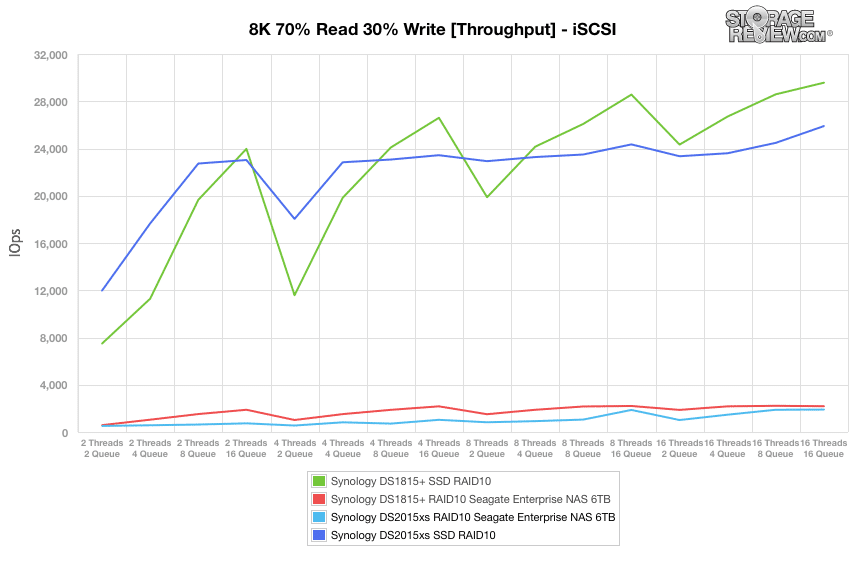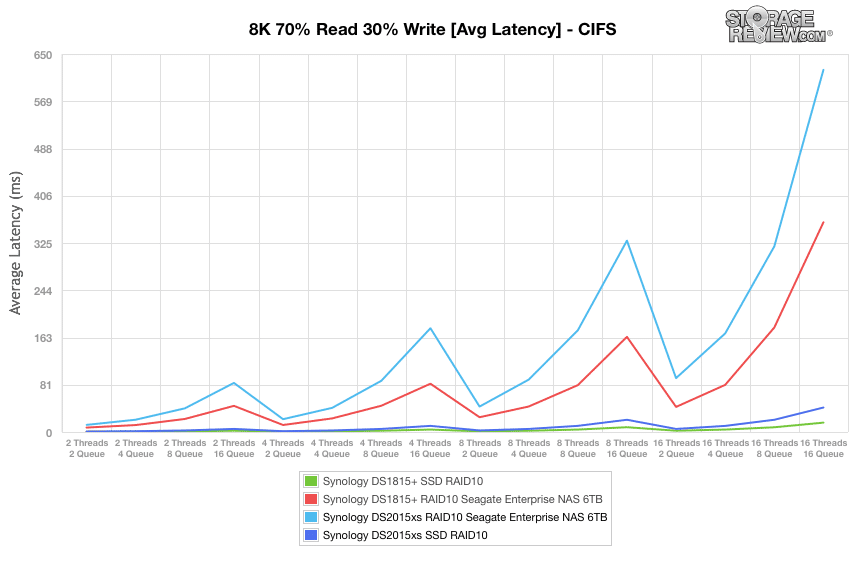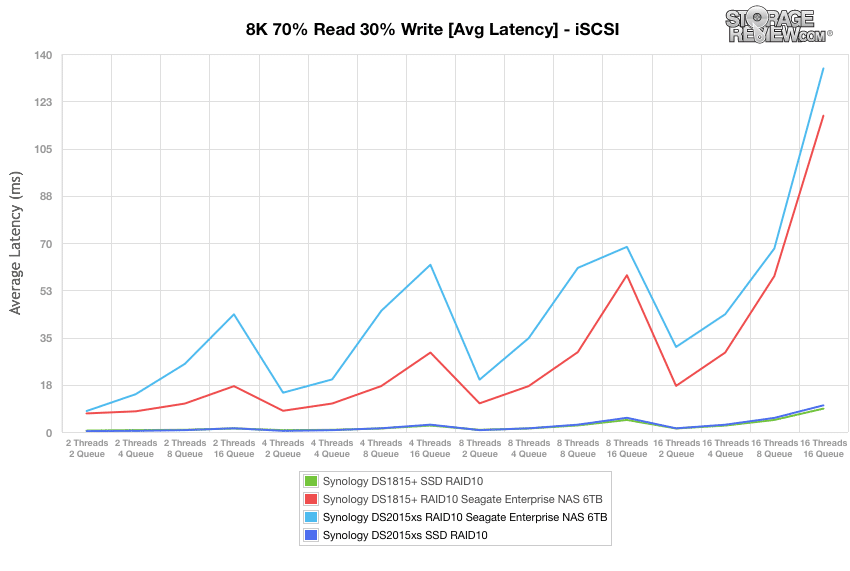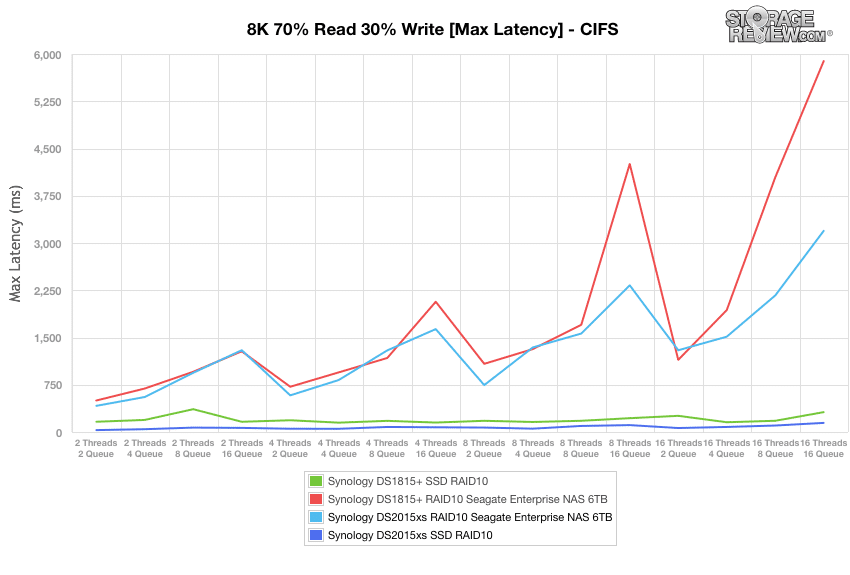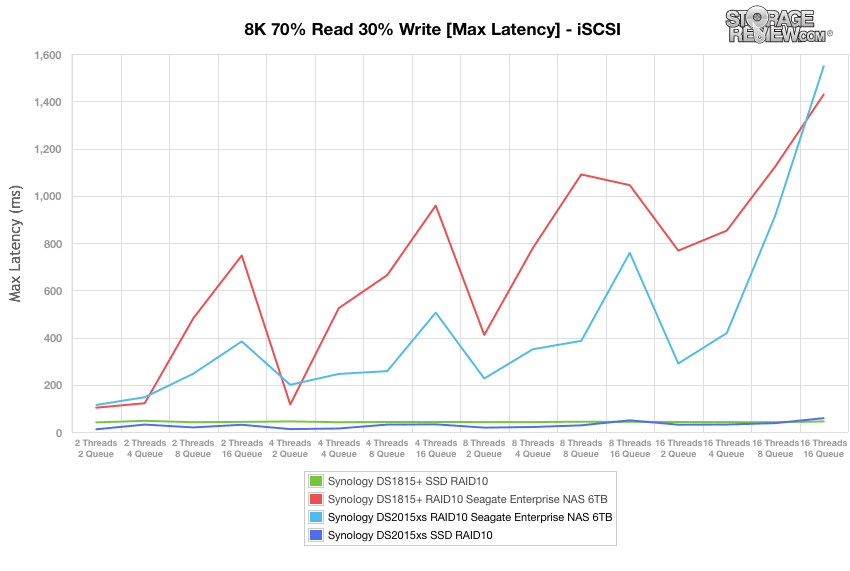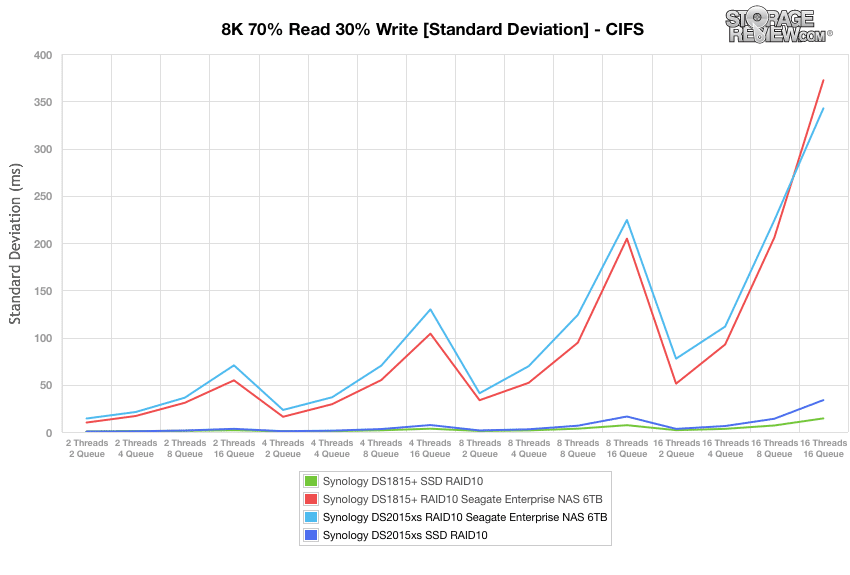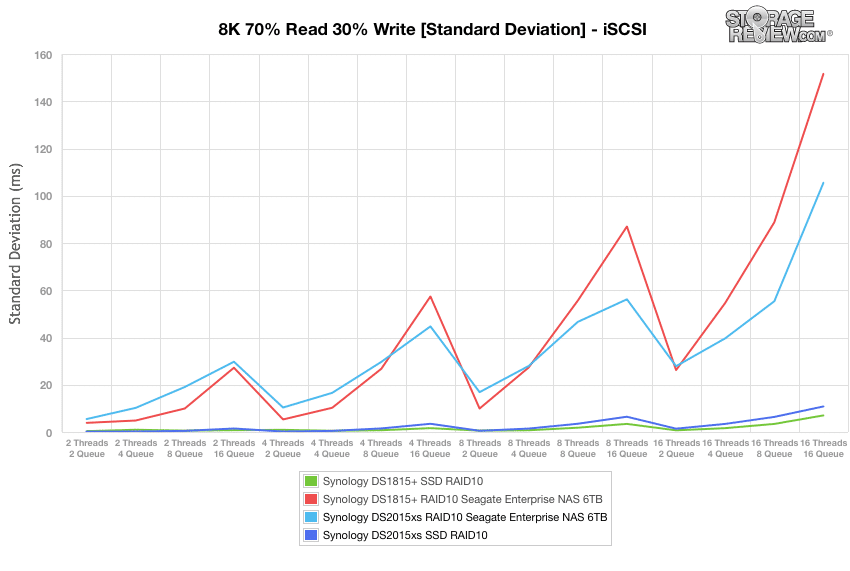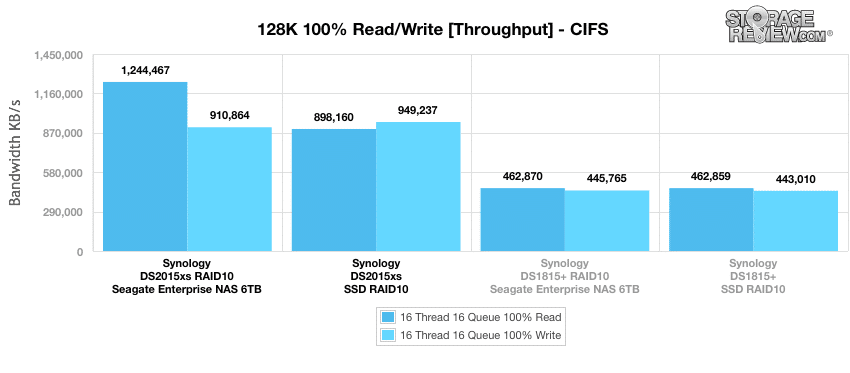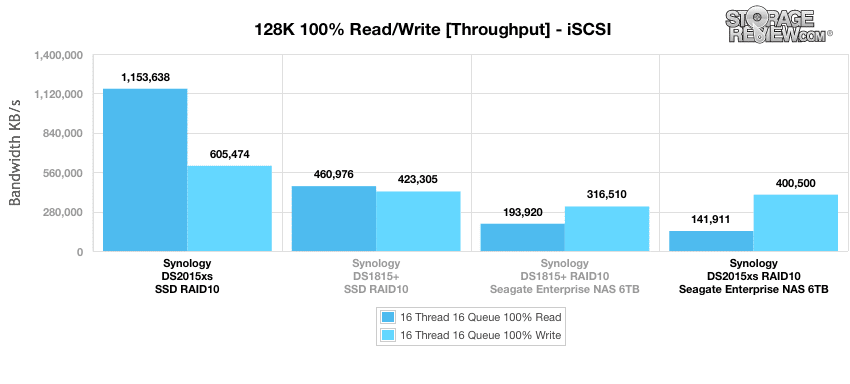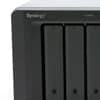
The Synology DiskStation DS2015xs is an 8-bay, tower-chassis NAS with a maximum internal capacity of 48TB that can be deployed in tandem with Synology’s 12-bay DX1215 expansion shelf for a total raw capacity of 120TB. With dual 10GbE SFP+ LAN ports, a 1.7Ghz Annapurna AL-514 quad-core CPU, and up 8GB of RAM, the DS2015xs is among the top tier of Synology’s NAS offerings in terms of hardware specifications.
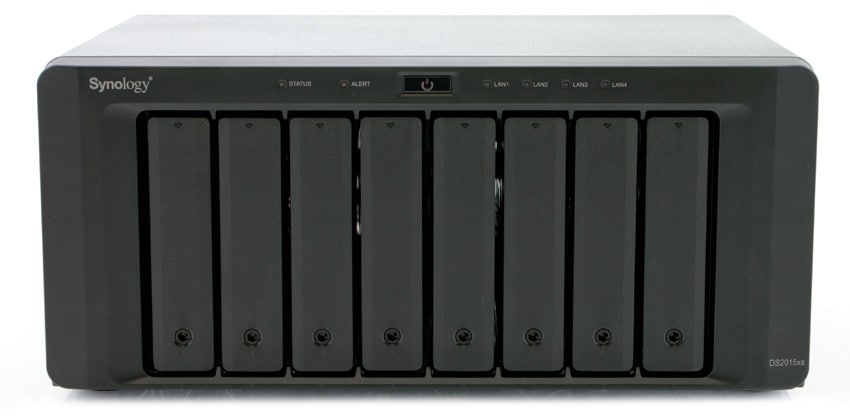
The DS2015xs has been engineered to provide the capacity and performance to serve as the primary storage array for small enterprises or as a robust local storage appliance for a branch office. Synology’s DiskStation Manager 5.1 (DSM) enables the DS2015xs to provide unified NAS and block storage with support for common file protocols including CIFS/SMB, AFP, and NFS as well as serving as an iSCSI target.
The DS2015xs can provide thin provisioning for file-level iSCSI LUNs alongside LUN backup, application-consistent LUN snapshots, and LUN cloning functionality. The DS2015xs can also take advantage of Synology’s high availability technology for active-passive clustering with another DSM-powered Synology storage appliance.
By incorporating the AL-514 processor, the DS2015xs is the first of Synology’s DiskStation systems to offer parity offload to accelerate RAID5 and RAID6 volumes. This processor architecture also allows Synology to forego a dedicated CPU fan in favor a passive cooling arrangement for the CPU. According to manufacturer benchmarks, the DS2015xs has been able to achieve a throughput of 1,930MB/s and 54,655IOPS for sequential read operations with link aggregation and when the DS2015xs is outfitted with SSDs in a RAID5 array.
When the DS2015xs is deployed with a combination of hard drive and flash storage, the array can leverage its DiskStation Manager to configure the SSDs as a cache to accelerate performance. As part of the DiskStation family, the DS2015xs can also handle printer sharing, VPN server, mail server, web server, and anti-virus duties for small business networks. The DS2015xs ships with support for the latest version of Synology’s Surveillance Station software which can support up to 40 cameras as well.
The DiskStation DS2015xs is offered with a five-year warranty and starts at approximately $1,400 without disks.
Synology DS2015xs specifications:
- CPU model: Annapurna AL-514
- CPU frequency: Quad Core 1.7GHz
- Floating Point
- Hardware Encryption Engine
- System Memory: 4GB DDR3
- Memory Module Pre-installed: 4GB X 1
- Total Memory Slots: 2
- Memory Expandable up to: 8GB (4GB + 4GB)
- Drive Bay(s): 8
- Maximum Drive Bays with Expansion Unit: 20
- Compatible Drive Type
- 3.5″ SATA(III) / SATA(II) HDD
- 2.5″ SATA(III) / SATA(II) HDD
- 2.5″ SATA(III) / SATA(II) SSD
- Maximum Internal Raw Capacity 48TB (6TB HDD X 8) (Capacity may vary by RAID types)
- Hot Swappable Drive
- External ports: USB 3.0 X 2, Expansion X 1
- File System
- Internal Drives: EXT4
- External Drives
- EXT4
- EXT3
- FAT
- NTFS
- HFS+
- Size (Height X Width X Depth): 157 mm X 340 mm X 233 mm
- Weight 5.31 kg
- LAN Number: SFP Gigabit X 2, RJ-45 x 2
- Link Aggregation
- Wake on LAN/WAN
- System Fan: 120 mm X 120 mm X 2 pcs
- Wireless Support (dongle not included)
- AC Input Power Voltage: 100V to 240V AC
- Power Frequency: 50/60 HZ, Single Phase
- Temperature:
- Operating Temperature: 5°C to 35°C (40°F to 95°F)
- Storage Temperature: -20°C to 60°C (-5°F to 140°F)
- Relative Humidity: 5% to 95% RH
- Warranty: 5 Years
Build and Design
The DS2015xs chassis design is nearly identical to its predecessor, the DS1815+, which we have also reviewed. This is the latest iteration of a tried-and-true design which has served Synology through the last few products in the DiskStation lineup. The chassis built from sheet metal and incorporates a front panel with LED indicators for power, system status, network activity, and drive activity.
The rear panel is provides exhausts for dual, redundant 120mm fans. In the event of a single fan failure, the system increases the speed of the remaining fan to compensate. On the right, the rear panel houses dual 1GbE ports, dual 10GbE SFP+ ports, and a SATA III 6Gb/s port to interface the DS2015xs with a DX1215 expansion shelf for increased capacity. Two USB ports are also available at the bottom-left corner.
As with other recent DiskStation offerings, the DS2015xs uses a tool-less drive bay design. Unless it is locked, the drive tray is opened by pressing the bottom of the bay cover to pop out a handle. The trays are compatible with 2.5-inch and 3.5-inch drives.
Management
The DS2015xs ships with Synology’s DiskStation Manager 5.1 (DSM) operating system. DSM is a mature and proven platform for configuring and administering Synology arrays that offers a broad range of functionality whether the DS2015xs is being deployed on its own or is part of a larger solution that incorporates multiple arrays.
DSM’s Storage Manager application organizes and monitors the storage capacity on the DiskStation and provides an interface for the creation of RAID and non-RAID storage configurations including volumes, disk/RAID groups, iSCSI LUNs, and iSCSI Targets. Storage Manager also provides access to configuration options for hot spare drives, SSD TRIM, and SSD cache.
DSM 5.1 provides support for virtualized environments including VMware, Citrix , and Hyper-V. The DS2015xs has been certified for integration with VMware vSphere 5 and VAAI with offloading capabilities for specified storage operations with VMware. The DS2015xs can provide virtual machine migration functionality along with Windows Offloaded Data Transfer (ODX) and Synology Advanced LUN support to improve the efficiency data transfer and migration tasks.
Synology’s Cloud Station application allows administrators to configure the DS2015xs to offer private cloud services along with a mobile app to synchronize data to smartphones and tablets. The DS2015xs can make use of Synology’s 2-way sync feature to keep designated data synchronized between DiskStation arrays in different locations. DSM 5.1 also allows the DS2015xs to join a Synology High Availability cluster with an active-passive architecture.
Testing Background and Comparables
We publish an inventory of our lab environment, an overview of the lab’s networking capabilities, and other details about our testing protocols so that administrators and those responsible for equipment acquisition can fairly gauge the conditions under which we have achieved the published results. To maintain our independence, none of our reviews are paid for or managed by the manufacturer of equipment we are testing.
For this review we will be compare the application benchmark results of the DiskStation DS2015xs outfitted with eight Micron M500DC SSDs configured as a RAID10 array to its predecessor, the DiskStation DS1815+, along with results from the Fujitsu Eternus DX200F, Huawei Dorado2100 G2, AMI StorTrends 3500i Hybrid Array, and the X-IO Hyper ISE 710.
Our enterprise synthetic benchmarks will compare the two Synology arrays when outfitted with both the Micron SSDs and with eight Seagate Enterprise NAS 6TB HDDs. The synthetic benchmarks will examine the DS2015xs’s performance for both CIFS and iSCSI protocols.
For this review we will use our Lenovo ThinkServer RD240 to drive the benchmark workloads and we will access the array via a Netgear ProSafe FS752TXS switch.
Lenovo ThinkServer RD240
- 2x Intel Xeon X5650 (2.66GHz, 12MB Cache)
- Windows Server 2008 Standard Edition R2 SP1 64-Bit running on VMware ESXi 5.1
- Intel 5500+ ICH10R Chipset
- Memory – 32GB (4x 8GB) 1333MHz DDR3 Registered RDIMMs
Netgear ProSafe GS752TXS Smart 52-port Switch
- 48 1GbE Ports, 4 10GbE SFP+ Uplink Ports
- 176Gb/s Aggregate Bandwidth
Application Performance Analysis
StorageReview’s Microsoft SQL Server OLTP testing protocol employs the current draft of the Transaction Processing Performance Council’s Benchmark C (TPC-C), an online transaction processing benchmark that simulates the activities found in complex application environments. The TPC-C benchmark comes closer than synthetic performance benchmarks to gauging the performance strengths and bottlenecks of storage infrastructure in database environments.
Our SQL Server protocol uses a 685GB (3,000 scale) SQL Server database and measures the transactional performance and latency under a load of 30,000 virtual users. In terms of transactions per second, the DS2015xs performs a bit below the DS1815+, although all comparables lie within a relatively narrow range of results.
Average latency results reflect a more tangible differentiation in user experience for SQL workloads. The DS2015xs experienced a higher average latency than the DS1815+ during the SQL Server benchmark with 73ms.
Enterprise Synthetic Workload Analysis
Prior to initiating each of the fio synthetic benchmarks, our lab preconditions the device into steady state under a heavy load of 16 threads with an outstanding queue of 16 per thread. Then the storage is tested in set intervals with multiple thread/queue depth profiles to show performance under light and heavy usage.
Preconditioning and Primary Steady-State Tests:
- Throughput (Read+Write IOPS Aggregated)
- Average Latency (Read+Write Latency Averaged Together)
- Max Latency (Peak Read or Write Latency)
- Latency Standard Deviation (Read+Write Standard Deviation Averaged Together)
This synthetic analysis incorporates four profiles which are widely used in manufacturer specifications and benchmarks:
- 4k random – 100% Read and 100% Write
- 8k sequential – 100% Read and 100% Write
- 8k random – 70% Read/30% Write
- 128k sequential – 100% Read and 100% Write
With the DS2015xs configured for access via CIFS and Micron M500DC SSDs, the array reached 4,953IOPS for read operations and 14,313IOPS for write operations in the 4k synthetic benchmark. When outfitted with Seagate Enterprise NAS HDDs, it reached 614IOPS for read operations and 2,242IOPS for write operations. Both configurations fell below the results of the DS1815+ with the same drive configuration.
iSCSI throughput performance for the SSD configuration reached 29,141IOPS for read operations and 25,894IOPS for read operations. The DS2015xs sustained 2,761IOPS for write operations and 1,588IOPS for read operations. As with the 4k CIFS benchmark, iSCSI throughputs were lower for the DS2015xs than the DS1815+.
Average latency measurements during the CIFS portion of our 4k benchmark clocked at 51.68ms for read operations with the SSD configuration and 17.88ms for write operations. With HDDs, the DS2015xs managed an average latency of 800.66ms for read operations and 147.35ms for write operations.
The average latencies we measured when the DS2015xs was configured as an iSCSI target where more competitive with the DS1815+ than when the DS2015xs was accessed via CIFS. With SSD storage the DS2015xs averaged 8.78ms for read operations and 9.88ms for write operations, and the HDD results were 82.71ms for read operations and 161.14ms for write operations.
Maximum latency measurements for the CIFS portion of the 4k benchmark protocol begin to show some of the advantages that the DS2015xs platform has over the DS1815+. When configured with the Micron 500DC SSDs, we measured a lower maximum write latency with the DS2015xs — 142.1ms compared to 418.8ms. The DS2015xs Seagate Enterprise NAS HDD configuration also had a lower maximum read latency than the DS1815+ at 2,100.2ms compared to 2,450.9ms.
With the iSCSI protocol and an array of SSDs, the DS2015xs managed a maximum read latency of 49.4ms and a maximum write latency of 83.9ms. With HDDs, the DS2015xs hit a maximum read latency of 1,055.2ms and a maximum write latency of 1,882.7ms.
Our next set of charts depict the standard deviation calculations for the 4k benchmark in order to compare how consistent latency results were during this protocol. The DS2015xs experienced a greater variation in latencies than the DS1815+ for both read and write operations when configured with SSDs and accessed via CIFS, although its 246.80ms standard deviation for read operations was significantly lower than the 510.28ms calculated for the DS1815+ when both were configur
ed with HDDs.
The standard deviation results for the two arrays have a similar takeaway when they were accessed via iSCSI: the DS2015xs SSD configuration had a larger variation in latencies than the DS1815+ for both read and write operations, but when configured with HDDs the DS2015xs had more consistent read latencies than the DS1815+.
The next benchmark used a workload composed of sequential 8k read and write operations, starting with the CIFS protocol. Regardless of whether the DS2015xs was outfitted with SSDs or HDDs it was not able to achieve half of the throughput of the DS1815+ array with the same storage media.
The 8k sequential outlook for the DS2015xs was somewhat better when the arrays were deployed as iSCSI targets, albeit only with HDD storage media. While the 22,645IOPS read and 22,461IOPS we measured with SSDs were not enough to surpass the DS1815+, the DS2015xs HDD configuration was able to double the DS1815+’s throughput for write operations with 18,959IOPS.
The next results are based on a test composed of random access 70% read operations and 30% write operations with an 8k workload across a range of thread and queue counts. When accessed via CIFS, the DS2015xs manages a consistent level of throughput throughout the variations in thread count and queue depth but is not able to surpass the performance of the DS1815+ during any part of the benchmark.
The DS2015xs again demonstrates a higher level of performance with iSCSI during the 8k 70/30 benchmark. When the DS2015xs is configured with the Micron 500DC SSDs it is able to outperform the DS1815+ at many points during this benchmark protocol.
While the DS2015xs does not experience any significant bottlenecks in terms of average latency during the 8k 70/30 CIFS benchmark, it is also not able to keep pace with the DS1815+ at any point during these tests.
With the average latency results for the 8k 70/30 iSCSI benchmark plotted it is possible to see how the HDD configurations for both arrays experienced similar latencies throughout the variations in workload. On the other hand, the DS2015xs had consistently higher average latencies throughout this benchmark when configured with SSDs.
The DS2015xs comes out looking somewhat better in terms of maximum latencies measured during the 8k 70/30 benchmark. When configured with SSD storage media, the DS2015xs does not experience the spikes in maximum latency of the DS1815+ with larger thread counts and queues of 16. The DS2015xs HDD configuration experienced lower maximum latencies than the DS1815+ throughout the benchmark.
The DS2015xs performed even better in comparison to the DS1815+ in terms of 8k 70/30 maximum latencies when configured with SSDs and accessed via iSCSI. Thus configured, the DS2015xs avoided crossing above 800ms until the upper range of the workloads for this benchmark.
Our standard deviation calculations for the latencies during the CIFS portion of the 8k 70/30 benchmark show that both arrays experienced a very similar range of latencies during both the SSD and HDD portions of the test.
When accessed via iSCSI, the standard deviation calculations were again comparable between the two arrays when configured with HDD storage. In keeping with the maximum latency results charted earlier, DS2015xs was able to keep its latencies to a smaller range of values than the DS1815+ when the arrays utilized SSDs.
Our final synthetic benchmark made use of sequential 128k transfers and a workload of 100% read and 100% write operations. When accessed via CIFS, this benchmark revealed the DS2015xs at its best performance against the DS1815+. The DS2015xs SSD configuration reached 1,244,467IOPS for read operations and 910,864IOPS for write operations, and the HDD configuration reached 898,160IOPS for read operations and 949,237IOPS for write operations.
The DS2015xs also performed well with 128k workloads when accessed via iSCSI. With SSDs, its read throughput of 1,153,638IOPS and write throughput of 605,474IOPS bettered the DS1815+, and the DS2015xs read throughput of 400,500IOPS with HDDs is also an improvement over the DS1815+.
Conclusion
Synology’s approach to storage appliances has been to provide a wide range of hardware in order to allow their customers to chose the right device for their circumstances. The DiskStation DS2015xs is a recent addition to the top tier of the Synology NAS family, falling into the category that Synology characterizes as “Large Scale Business.” As such, it incorporates a number of refinements that are meant to support those deployments like 10GbE, along with Synology’s powerful DiskStation Manager operating system.
In terms of its performance during this suite of enterprise benchmarks, we did not find it able to surpass the performance of its mid-market cousin the DS1815+ except in a few specific situations. We should point out that in order to compare the performance of the DS2015xs to other systems which we have benchmarked, we did not use RAID5 or RAID6 volumes which would be able to leverage the AL-514 CPU’s parity offloads to improve the array’s performance. For those who configure for that, there should be additional upside.
Pros
- Upgradable to a total of 120TB of storage capacity and 8GB of system RAM
- Proven DiskStation Manager operating system and management interface with a robust ecosystem of built-in and optional applications
- Passively cooled processor reduces power requirements and possible points of failure
Cons
- Lackluster performance compared to the Synology DiskStation DS1815+ across most benchmarks
Bottom Line
The Synology DiskStation DS2015xs features an updated hardware platform which excels in certain use cases, but all-around performance in our benchmarks is only occasionally exceeds that of its predecessors.
Synology DiskStation DS2015xs at Amazon

